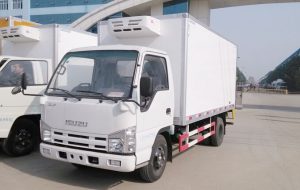
Dedicated to Provision of Long Term Stable Running IoT Devices
- mailbox
 [email protected]
[email protected] - phone
 +86-755-85241929
+86-755-85241929

Dedicated to Provision of Long Term Stable Running IoT Devices
 [email protected]
[email protected]  +86-755-85241929
+86-755-85241929 New technologies continue to provide new opportunities and innovative solutions. One of the most important new solutions to time-temperature abuse of perishable foods is the remote temperature sensor.
Time-temperature abuse is the concept that perishable foods are only safe and edible if they are kept at a specific temperature during storage, transit, delivery, and final handling. As the food supply has become global with highly perishable foods, like fish, meats, and some vegetables, being delivered to the other side of the globe, the time that food may be warmer than recommended must be controlled.
Global Shipping Needs Global Solutions
Historically, all foods were preserved if they were to be eaten any time after a few days of harvesting. Meats were often smoked, dried, salted, or pickled. Fruits and vegetables were preserved using similar techniques.

The advent of refrigeration, both in shipping and the home, changed everything. Fresh foods could be transported and stored so they could be delivered far from their origins. Even frozen foods make eating nutritious vegetables easier.
Transportation is fast enough that we can send fresh foods thousands of miles, often around the globe, in just a few days.
Since refrigeration is the key to keeping the foods safe, guaranteeing that it’s kept at the right temperature is vital. The answer to that is remote temperature sensing.
Trust but Verify:Every day, whether we are buying food for our family or for an entire army, we trust that the people who brought food to us have been tracking the temperature every step of the way.
With devices, such as wi-fi, cellular phone, GPS, or Bluetooth temperature sensors, we can now do more than hope.
The concept is simple, but it required the right technology to make it happen. A remote temperature sensor is placed into a shipping container, box, or bag. The device senses the temperature at all times. It also tracks its location via GPS and can be made to track other data as well. The data is delivered using wi-fi or cellular technology to a site online. The user can then log into the site and see both the temperature and the location of their products.

The information can be stored for later analysis. This is a type of data that would be vital to have in case of alleged food poisoning from spoiled foods.
The Consequences of Lax Time-Temperature Controls
Foodborne Illness:It is estimated that foodborne illnesses annually cost more than $50 billion in the United States and cause more than 120,000 hospitalizations and 3000 deaths (Scharff2012; CDC 2016).1
Foodborne illness is something most people have experienced, but it’s nearly impossible to prove unless there is a large scale. For the individual, most of these illnesses cause high fevers, vomiting, diarrhea, cramps, and more. Death is a definite possibility. The vast majority of these illnesses can be prevented by keeping the food cold the entire time from harvest to preparation.
Food Waste:The United Nations estimates that each year approximately 1/3 of all food produced for human consumption is wasted, while other reports indicate that food waste accounts for 40% of production (FAO 2011; NRDC 2012).1
The annual economic impact of food waste is estimated at $218 billion in the U.S., $143 billion in Europe, and $27 billion in Canada (Young 2012; ReFED2015; FUSIONS 2016).1
Consider that we waste 40% of all food produced for human consumption how much easier it would be to feed everyone if we didn’t have to throw out food because it had gone bad.
Vigilance as a Marketing Tool:Some companies has caught onto the idea that displaying their violence against time-temperature abuse is a great marketing tool. Television commercials showing the tracking system have shown up that tout the importance of knowing exactly what happened to every box of food.
For those companies that have a concern about foodborne illness, which is, in reality, every company that grows, ships, or sells food, the remote temperature sensor is a welcomed new technology. The ability to look customers in the eye and say, “I can guarantee that that piece of fish was kept at safe temperatures from the ocean to your plate,” will go a long way to winning brand loyalty from consumers.
The Other Bottom Line:The costs of foodborne illnesses listed above don’t discuss the millions of dollars that are paid out to consumers and employees to thwart lawsuits. Very few lawsuits make it to court, but it can be very expensive to keep them out of court.
The Chipotle Restaurant chain has had over a half dozen documented outbreaks in the past 15 years. In one case in Ohio, over 400 people got sick. If each of those people is just awarded medical expenses, it can easily reach into the millions. That doesn’t begin to account for the punitive damages that a jury would give to victims. There is no public record of how Chipotle handles the situation, but many victims stated that they intended to sue.
Elegantly Simple Answer:Wireless temperature sensors are a simple, elegant solution to a problem. When a device is tossed into a box or a shipping container, it can help to guarantee that the food that arrives that another end is safe. A complete record of the temperature and the journey can ensure food safety and avoid embarrassing headlines.
All of this technology can be had in both off the shelf and custom solutions. Since every vendor has different needs, remote temperature sensors can be adapted to use, packaging, and destination.